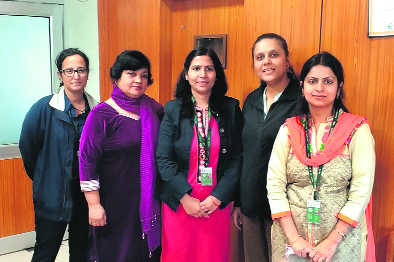
TBRL scientists (from left): Devarati Bhattacharya, Rajesh Kumari, Meenakshi Bhatkula, Vandana Arya and Sakshi Arora.
Vijay Mohan
Tribune News Service
Chandigarh, March 7
As soldiers strap on bulletproof jackets that prevent injuries from small arms fire during anti-terror operations or climb into armoured vehicles that can withstand improvised explosive device blasts, a handful of women scientists have been plugging away in laboratories hundreds of kilometres away to ensure the gear being used meets the requisite standards of protection.(Follow The Tribune on Facebook; and Twitter @thetribunechd)Not many women in India get to work with bullets and bombs, but a small but select group of women scientists have successfully made a career at the Terminal Ballistics Research Laboratory (TBRL), a Defence Research and Development Organisation unit that evaluates the performance of ammunition and warheads.Speaking to The Tribune on the eve of International Women’s Day, some of them shared their experiences and perception of being associated with what is considered by many as a “dangerous field”.“It is a highly challenging subject and we have been involved in establishing test protocol of various types of ammunition and explosives, for which no well-defined parameters existed earlier,” says Dr Rajesh Kumari, a senior scientist who has been associated with the subject for 25 years. “The safety aspect is very important in our work and all activities involve a lot of planning and deliberations under set procedures,” she adds.“It’s a great responsibility,” says Dr Devarati Bhattacharya, an engineer who joined the DRDO 11 years ago. “The most satisfying aspect of our job is that the soldiers on the borders are able to get better protectionbecause of the work we do,” she says. While women still form a small percentage of the technical workforce, their number in the DRDO has steadily grown over the years. “In 1989, there were only three women scientists in the TBRL. We now have 25 women scientists and an equal number of technical officers,” says Meenakshi Bhatkula. “We do the same work as our male counterparts and are adjudged equally,” she says.The relatively low number of women in the DRDO is a societal reflection and the ratio is similar in other fields, points out Dr Vandana Arya, a veteran of 14 years.Women scientists also need to balance their profession with household responsibilities. A lot of what they do at the laboratories remains under wraps and only a few broad details get shared with family members. “Unlike most male colleagues, women also have additional domestic responsibilities to take care of and time management becomes imperative,” says Sakshi Arora, who joined the defence establishment 10 years ago.“There are times when you have to work late into the night during important tests or travel away from home,” she adds. At times an important demonstration may be held up for hours or even days simply because of a cloud overhead.How family members look at an explosive expert amongst them is summarised by Dr Vandana, when she says: “There have been instances when I have returned home and my daughter has simply told me, ‘Mom, your clothes smell bad,’ as I had been working with chemicals and explosives the whole day.”
